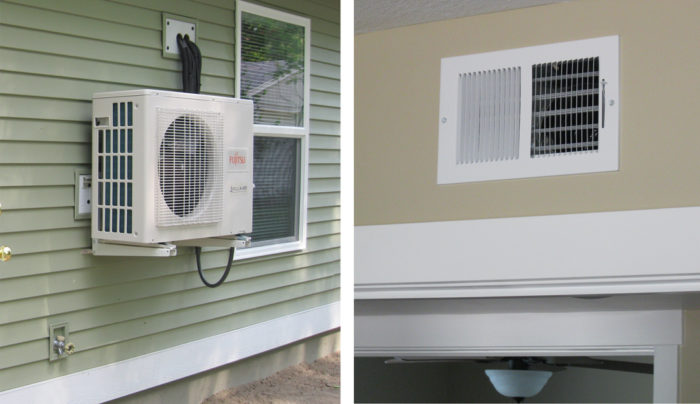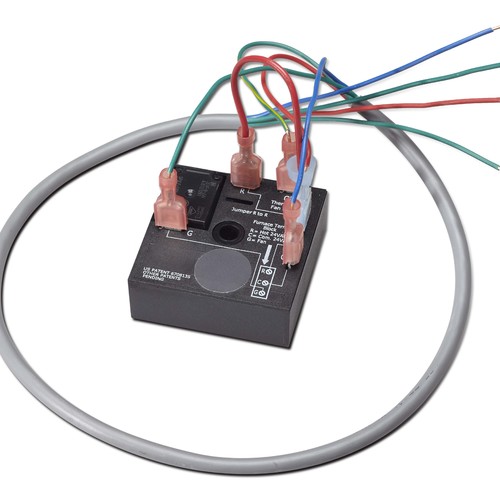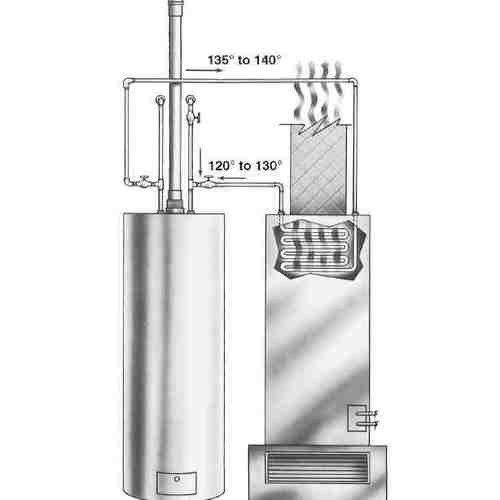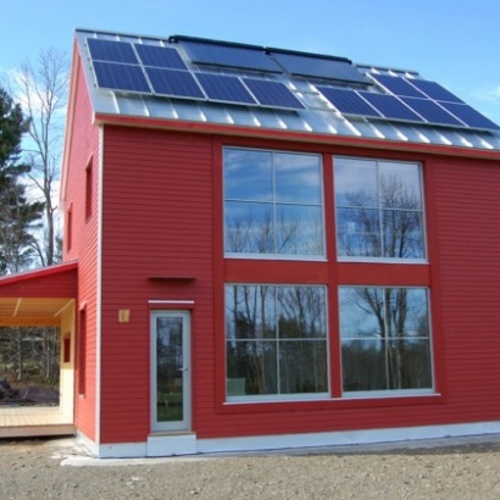
Image Credit: Habitat for Humanity - Grand Traverse Region
Last night, I enjoyed an intense conversation with my friend Bill Updike. Bill, who has been closely following the developing partnership between PHIUS and Building Science Corporation, is the green building specialist at the Washington, D.C. Department of the Environment.
We were talking about cost-effective energy-efficient design, and Bill tossed off a comment that the key to any design — at least in our mixed-humid climate here in Maryland — should be the latent load of the building. When he said that, my mind lit up like a pinball machine showing three cherries.
Here’s why: The latent load of a building — in effect, the amount of humidity inside your home that has to be removed for you to feel comfortable — is largely independent of how much insulation you use in the floor, walls, and roof, as well as the qualities and disposition of the other components of the building envelope. You can thicken your insulation as much as you want, but you will not substantially reduce the latent load.
So then, why not select the most efficient heat pump that will handle a given latent load, and then scale the envelope components to the point where that same heat pump can just handle the heating load during the winter months?
The fatal flaw in the Passivhaus approach
This approach would be in contrast to Passivhaus methodology, where envelope and mechanical system design begins with the established value of 4.75 kBtu per square foot per year for specific heat demand.
Generally speaking, using the Passivhaus system, the insulation values are beefed up until the predicted annual heat load is no greater than that value. In theory, that is the point at which the ventilation system — in our climate, a system based on an ERV — is capable of distributing not only sufficient fresh air, but also the heated air required for thermal comfort. At that point, as the theory goes, a conventional heating system can be eliminated — in turn saving enough construction cost to pay for the extremely high levels of insulation and other envelope components that were necessary to hit the magic 4.75.
The fatal flaw of this system, however, is that even when the envelope is designed to achieve Passivhaus certification, the ventilation system may not be adequate to manage the latent load. So a conventional mechanical system remains necessary — and the higher levels of insulation required for Passive House provide what can then be considered unjustifiably diminished returns.
Elevating latent load to a new position of importance
So it seems reasonable to approach energy design from a individually determined performance standard — that is, latent load — instead of an arbitrary value, like the mystical 4.75 kBtu.
This provides a rational basis that hopefully avoids the rapidly diminishing return for extreme levels of insulation.
Reducing the small-house penalty
Of extreme importance is that it may tend to offset the penalty that Passivhaus imposes on smaller houses, where the higher ratio of wall area to floor area exacerbates the diminishing return phenomenon. Conversely, none of this negates the value of PHPP or WUFI-Passive as design tools.
It was Deep Throat who said, “Follow the money.” When it comes to designing energy-efficient homes, it’s still good advice: to follow the money into the thickness of your walls, roof, and particularly your subslab insulation. But I think the real story is to “Follow the water vapor.” That is the key, in my book.
So, thank you, Bill, for this epiphany. I’m eager to try this approach on the next project. It may be that the results will not be too far off from a straight-up Passivhaus analysis. I’ll keep you posted…
Alan Abrams is a Certified Passive House Consultant, a Certified Passive House Builder, a
Certified Green Professional (NAHB), and a Certified Professional Building Designer (American Institute of Building Designers). He is also the owner of Abrams Design Build in Takoma Park, Maryland.
Weekly Newsletter
Get building science and energy efficiency advice, plus special offers, in your inbox.













19 Comments
Aesthetics
Are there any better ways to mount the outdoor units without having them hang on a wall like that? I know must HOA communities would NOT allow for it to be mounted like that. The exposed refrigerant lines, power lines, and bulky compressor unit hanging on the exterior wall would make most architects and HOA boards cringe at the thought of it. There has to be a better way to mount them.
Response to Peter L
Peter,
Outside of the colder regions of the U.S., where we don't have much residential air conditioning, it's common to see very large, ugly air conditioner condensers on the outside of homes. People down South have gotten used to them -- it's as if they don't even see them any more.
I'm not quite sure why some people object to the slimmer Japanese units built by Fujitsu and Mitsubishi -- they are usually smaller than their American cousins (shown below).
.
Wall mounting mini-splits.
When used for both heating & cooling it can be important to mount the bottom of thing higher than the historical snowpack depth, and protected by roof overhangs (rake is better than eaves) to limit the potential for damage from roof-avalanche/drift burial, or cornice-fall, etc. In my area people who ground mount them in the open usually have to dig them up 1-3 times per year and run a manual de-frost by switching to air-conditioning mode to clear the snow. Even when protected by a an open-wall dog-house, there's at least some digging involved in snow country:
http://i46.photobucket.com/albums/f147/Xringer/NCL/Sanyo-1.jpg
http://techno-fandom.org/~hobbit/hse/log/257215/2296daikburied.jpg
Bracket mounting on the wall isn't a bad option here!
If you're ground-mounting them it's pretty simple to screen them visually with shrubbery or low lattice fencing, as long as you don't put the visual screening elements so close as to inhibit air flow. (http://i212.photobucket.com/albums/cc195/RedXray/MiniSplit.jpg ) Mounting them under lattice-ventilated porches and the like works just fine. Most mini-split compressor units aren't very tall, and are pretty easy to screen off. Even a 2.5 ton AC unit like the Mitsubishi PUYA30NHA4 is less than 28" tall, and can hide behind shrubs nowhere near tall enough to reach the windows.
The refrigerant & control lines don't need to run in an exterior conduit either, though that is a common solution in retrofits. When in a conduit the visual impact of the lines is no greater than a gutter downspout.
http://www.zimmermansac.com/Mitsubisi-Mini-Split-Ductless%20_2_3261902615.jpg
http://www.uptownheatingandcooling.com/wp-content/uploads/2013/03/mini-split-outdoor-unit-condenser-1024x768.jpg
But the most common way to deal with the visual noise where the HOA folks care (just as with the traditional cube form factor) is to put it on the side of the house least visible from the street.
The Latent South
Isn't it curious that "latency" is a word for both high humidity and slowness? I'm convinced the US Southeast traditionally talks and moves more slowly because of our hot humidity.
All it takes is a few kids opening and closing the door ten times a day throughout the summer to wipeout any benefit of an ultra tight air barrier. Airlocks or vestibules should be a standard strategy in humid climates with independent humidity control. I'd love to see more research and calculations on their payback.
Steve Hall
http://SteveHallArchitecture.com
Thanks!
Alan,
Thank you for so wonderfully articulating what has been a nagging concern of mine for quite a long time. As I have mentioned before here on GBA, it is very difficult for me to imagine a highly insulated home in the mid-Atlantic climate which still wont depend on some mechanical way remove the excess moisture during our sticky summer months. And so if I have to assume that the equipment must be there, what then is the "sensible" (pun intended) amount of insulation to design for? There must be a way to figure out the right sizing of both the insulation and the equipment all the same time, right?
And as Steve mentioned, there's no way to stop the kids from opening up the doors ten times a day. (During our snowstorm last Thursday, I believe I counted our door(s) being opened by myself & the kids AT LEAST 25-30 times that day.) Although the airlock idea is a good one, how must one account for that type of use over the course of a year? A 2,000 sqft. home with two adults, three children, one home business, and a handful of miscellaneous plants and pets will have a VERY different seasonal latent heat load than a 2,000 sqft. home with two occupants who both leave the house all day.
How does one design for that big of a difference, and whose to say what the next family "heat profile" will look like?
Best,
Matt
Aesthetics and Latent Load
First, I agree with Martin.
I have the only minisplits in my entire, large neighborhood. Although the best scenario would be to have no outside unit, my small units look a lot better than all the huge ones everyone else has. Mine is a lot quieter too, partly because they really don't run much in the winter with superinsulation. The upstairs one hasn't been on at all in the winter, even with some 4-5F nights.
After going through all last summer IN MARYLAND with my minisplits, I couldn't agree more that latent load around here is most important. As good as my Fujitsu 12RLS2 (downstairs) is for winter, the combined effort of that unit and a 9RLS2 unit upstairs cannot keep up with the humidity around here. There is plenty of sensible cooling load to keep the units running, and they are lucky to keep 76-78F sometimes, even when set at a lot lower temperature than that. But the units just could not dehumidify the air to the extent claimed by Fujitsu. No matter how many times I tried, and no matter what the settings used on the two units, neither unit ever removed any more than about half the amount of water per hour as claimed by the Fujitsu specifications. Humidity often remained above 60%, and we often had to run a dehumidifier upstairs to sleep comfortably.
Latent loads in low-gain houses...
... can be difficult to manage with a mini-split alone. But there's one line of mini-splits head & shoulders above the rest on latent load managment:
The Daikin Quaternity series mini-splits have independently settable RH and temperature settings, can dehumidify without even a hint of sensible cooling, and can even dehumidify while in heating mode.
The down-side to that series is that they're not fully characterized below +14F outside temps, which can be an issue for places with outside design temps lower than that. They don't stop running during cold weather, and will still be putting out something at 4-5F outdoor temps, but the output is unspecified, so one can't legitimately size the unit for heating apps in cooler climates with design temps cooler than that (though one could simply guess.)
not enough info on mixed climates
Most green home bloggers that I've seen focus on the needs of cold climates, which makes sense to a degree because heating homes in cold regions is where most efficiency gains can be realized. But it's really hard to find info on the equipment and system design for mixed-humid and hot-humid climate regions. Mixed-humid seems particularly tough, because winter temperatures regularly fall into the 20s and summer highs are often in the 90s (with very high humidity!). Is it possible to design a mini split system that can adequately condition a house in such a climate? I've read everything I can find on this topic, and frankly I don't know. It would be nice to see GBA do more posts like this; in my opinion the editorial staff focuses too much on building in New England.
Response to David Hicks
David,
Thanks for your comments. We appreciate the feedback.
I'd like to take the opportunity to announce that GBA welcomes guest blog submissions from designers and builders, and we are especially eager to publish articles about projects in hot, humid climates or mixed climates. Submissions can be sent to my attention by e-mail, to: martin [at] greenbuildingadvisor [dot] com.
Response to David and Steve
This dialog brings to bear the nagging issue that underlies its topic--that is, the inherent fragility of what we build due to its vulnerability to moisture.
In my original blog post, I omitted the discussion that preceded the "epiphany." What I said to Bill Updike that evening--spoken arguably in desperation--was that perhaps we are veering off into the weeds with our pursuit of these immaculate levels of airtightness and wall thickness, and that maybe the best approach for affordable, mass produced housing--a resource that is substantially denied to upcoming generations--maybe the best approach is some good prescriptive formulas based on regional climate, and most importantly, with a focus on vapor management.
Steve's observation of the kid's running in and out of the house all day reinforces that notion. And just imagine if the kids have a dog they need to coax along with them.
More fundamentally, we need to take a reality check on our own, personal requirements for thermal comfort. My mother grew up in an affordable mass produced home built at the brink of the Great Depression. The house included a state of the art device for mitigating latent loads during the swampy summers of Washington, DC: a sleeping porch. It would not provide ASHRAE levels of thermal comfort, but it damn sure was net zero.
You can see where this is going. Maybe the problem is not so much in calibrating the astonishing technology of ultra efficient minisplits, but in recalibrating our expectations, and our exaggerated sense of entitlement...
...sigh...end of rant...
-AA
Response to Alan
Changing expectations of comfort does not tell the entire story, however. The climate of DC has changed quite a bit since the 1920s. I've lived in Alexandria for about 25 years and it's changed even in that time! Here's an item that shows the increase in temperatures over the last century: http://www.washingtonpost.com/blogs/capital-weather-gang/post/is-there-a-global-warming-signal-in-dc-summer-temperatures/2011/08/09/gIQAtLkz4I_blog.html Note that average nighttime lows are increasing at 4.6 degees F per century. These readings are from Reagan National Airport, of course, but I would not be surprised if areas with denser construction (more concrete and air conditioners per sq ft) had even higher rates of increase for nighttime lows. Just last summer, we set a record for most consecutive hours above 80 degrees -- 138 hours to be exact.
Occupant behavior goes hand in hand with comfort level. How many busy professionals plug in their crock pot in the summer and leave it there generating heat all day, then come home and crank the thermostat down to 68 just to get all the vapor that escaped from their dinner back out the air? Or my friend who boiled 5 gallons of water to brew beer in his kitchen in the middle of July.
If minisplits can be used to manage latent loads effectively, I think they could work very well in the DC climate. My a/c is oversized for my small apartment, so the constant cycling leads to stagnant air, and it generally needs to be at 72 or lower to keep humidity down. A stream of air coming from a minisplit at a low- or no-load compressor state might just be the ticket.
What's wrong with just having
What's wrong with just having a dehumidifier?
It seems to me that it takes a certain amount of energy to handle the latent load, and it takes a certain amount of energy to handle the sensible load. I realize that dumping the heat from the latent load outside of the house handles the sensible load in some situations. However until someone invents a heat pump that can choose where it dumps BTUs (ie if it only needs to handle the latent load the heat pump acts like a dehumidifier rewarming chilled air via an inside heat exchanger, if it needs to cool the air the BTUs are dumped to the outside heat exchanger, or maybe a mixture of the two) then one system will never be able to really efficiently handle all situations.
occupant behavior/passive house baseline
David's point about the dramatic rise in local average temperature is well taken; it goes to the greater discussion of resilience.
dropping back to illustrate my point that our expectations matter--I did some tweaking of my PHPP file for the Grant residence, changing the summertime overheating value to 80dF from 77, and the winter interior design temperature to 66dF from 68. I keep the T-stat in my own uninsulated home (it's a high rise condo--I have no access to the wall cavities) set to 66, and I'm comfy with a fleece sweater on . In a modern house, with modest insulation in the walls, and low e- glazing, radiant heat loss is significantly defeated, further raising comfort levels.
The effect of these changes on the PHPP verification page is significant. Specific space heating went down to 3.95 kBtu(ft^2yr) from 4.73. Specific cooling demand was cut in half, to 1 kBtu(ft^2yr) down from 2.
Specific primary energy load (energy consumed at the generating station, and including line losses) went down to 33.8 kBtu(ft^2yr), down from 35.0. That is the equivalent of 610 kWh (or 226 kWh at the meter of the house)
looked at another way--it would have allowed the house to achieve PH certification with 2 1/2" of subslab insulation, instead of 9".
None of what is suggested here is a hardship. I think it is reasonable for PHIUS to consider giving people the option of defining their own comfort standard. We are all grownups, I presume.
-AA
more on the Grant residence:
http://www.abramsdesignbuild.com/does-a-passive-house-have-to-look-weird/ et cetera
alan abrams I concur
Fantastic blog. I really could use much much more of what you have to say alan. Great blog. Bravo
aj
Dana alan is on to something that I have been thinking for years
There are good unintended consequences sometimes... as in the fact that a PGH home just may also benefit from energy savings by giving comfort at temperatures and humidities that with poorly insulated homes would be uncomfortable thus further saving energies and expenses.
Along the same line of thought... design temperature HVAC design is wrong today for PGH homes IMO. PGH homes can be built to coast thru coldest design temperatures and should be. There are many ways to deal with times where non design conditions outlast the ability of all to coast by. IE.. daytime temperatures may allow mini splits to heat a PGH home when the night time temps don't pencil out. And just the opposite for cooling a home, get it cool during the most favorable early morning low temperatures. A Bruce Brownell home with all the building mass to the interior might aid all this diurnal coasting. Bruce mentions the cost of dealing with latent loads...
If the idea is to reduce... costs and pressures on our human future, we need to reduce in all ways possible not take what we improve and add to our negative impact on the planet. The days of exact temperatures and humidities should be gone till we all prove the planet can afford such luxury.
heat pump snow roofs
Fuj and Mits engineers need to include a design for optimal snow roofs in the installation manual.
My Fuj 9RLS2 requires 24" (2 feet) of space above the unit, placing a roof pretty high above. When I experimented with a snow roof that high, the snow melted during warmer temps and then refroze while falling, similar to icicles from a roof edge, and then those icicles got sucked into or feel into the fan blades! Falling blowing snow would also fall into the unit when the blades were not moving, and then freeze inside the pan.
And none of the heat eff numbers include the substantial juice used by a pan heater, and I haven't seen a model yet with an efficient way to determine when to turn it off. There goes 60-100 watts full time to heat the outdoors basically.
latent load
"when the envelope is designed to achieve Passivhaus certification, the ventilation system may not be adequate to manage the latent load.".
I'll argue that in most cases, it is. Latent load primarily depends on air sealing and Passivhuas standards *have* addressed that. So the ERV will move enough air. See "DOAS" for more information.
Response to Jon R
Jon,
You are displaying cold climate bias. You claim that an "ERV will move enough air" to handle a home's latent load. But in a hot, humid climate, the outdoor humidity levels are higher than indoor humidity levels. So blowing lots of air through your ERV only makes your situation worse. The more you ventilate, the more moisture you introduce into the house.
In hot, humid weather, an ERV can't lower the indoor humidity level. What you would need in that case would be either an air conditioner or a dehumidifier.
Latent Load
All- What we speak of is - what is my home's latent load? It boils down to the fact that we now must address each load as a separate entity. We have historically been addressing latent load using an air conditioning system (big ones in leaky houses) as a by product of sensible cooling (selecting a temperature set point). Now that we may have the sensible load under control in our 'passive house'- it becomes apparent that the latent load is no longer related to sensible and therefor must be addressed separately. From PHIUS beginnings- I was asked to develop "latent degree days" as I coin the phrase now. And interesting as that sounds, and as much as I would like to do that... I have a day job that keeps me busy. However- I am close. Its not rocket science. SO- we need latent degree days for climates and then we can use that to determine a latent load after we apply the ERV latent efficiency and ventilation flow.... for a particular house (with respect only to a passive house). There's a little more to that.. but lets keep to the point. Then- how much can that annual estimate vary year to year? I'll wager it is a larger fluctuation than HDD (which can vary +/- 20%). So even if I know the latent degree days- and can find a latent load- and have a piece of HVAC equipment that can efficiently 'dehumidify' (control humidity with a known latent capacity)... what if the actual latent degree days can fluctuate year to year by 50%? How do I size it? Fun stuff
Log in or create an account to post a comment.
Sign up Log in